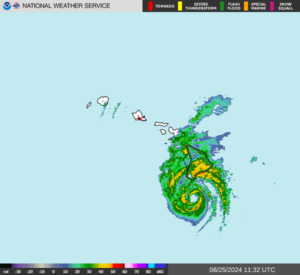Typhoon Shanshan continues to strengthen over the Western North Pacific Ocean south of Japan on Sunday. At 11:00 p.m. EDT on Sunday the center of Typhoon Shanshan was located at latitude 27.3°N and longitude 133.5°E which put the center about 350 miles (565 km) south-southeast of Kagoshima, Japan. Shanshan was moving toward the west-northwest at 12 m.p.h. (19 km/h). The maximum sustained wind speed was 90 m.p.h. (145 km/h) and there were wind gusts to 115 m.p.h. (185 km/h). The minimum surface pressure was 968 mb.
Typhoon Shanshan strengthened gradually on Sunday as it moved over the Western North Pacific Ocean south of Japan. A large circular eye was present at the center of Shanshan’s circulation. The eye was surrounded by a ring of thunderstorms and the strongest winds were occurring in that ring of storms. Bands of showers and thunderstorms were revolving around the core of Typhoon Shanshan. Storms near the core of Shanshan’s circulation generated more upper level divergence that pumped mass away from the typhoon. The removal of more mass caused the surface pressure to decrease.
The size of the circulation around typhoon Shanshan increased slightly on Sunday. Winds to typhoon force extended out 35 miles (55 km) from the center of Shanshan’s circulation. Winds to tropical storm force extended out 145 miles (230 km) from the center of Typhoon Shanshan.
The Hurricane Intensity Index (HII) for Typhoon Shanshan was 13.9. The Hurricane Size Index (HSI) was 11.7 and the Hurricane Wind Intensity Size Index (HWISI) was 25.6.
Typhoon Shanshan will move through an environment that will be favorable for intensification during the next 24 hours. Shanshan will move over water where the Sea Surface Temperatures are near 29°C. It will move under the northern periphery of an upper level low south of Japan. The upper level low will produce easterly winds that will blow toward the top of Shanshan’s circulation. Those winds will cause some vertical wind shear, but the wind shear will not be enough to prevent intensification. Typhoon Shanshan will intensify during the next 24 hours.
Typhoon Shanshan will move around the western end of a high pressure system over the Western North Pacific Ocean. The high pressure system will steer Shanshan toward the northwest during the next 24 hours. On its anticipated track, Typhoon Shanshan will move closer to Kyushu and Shikoku. Shanshan could approach southwestern Japan in 48 hours. Shanshan could be a strong typhoon when it approaches Japan.

